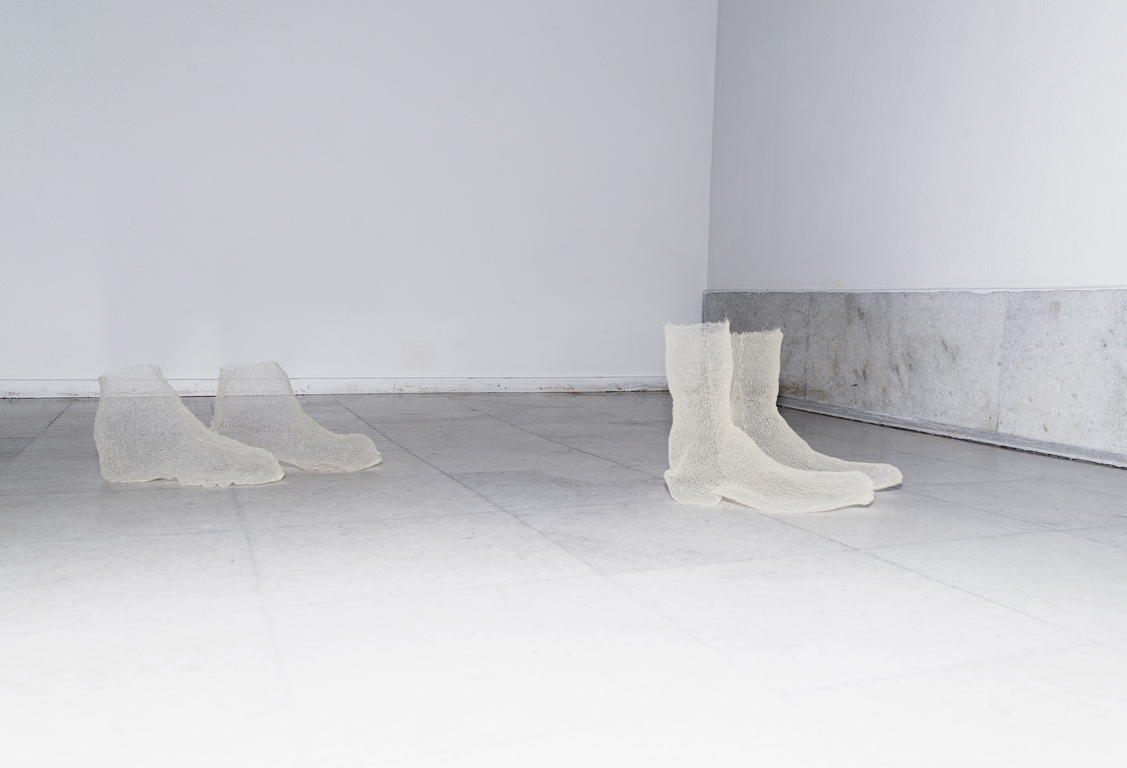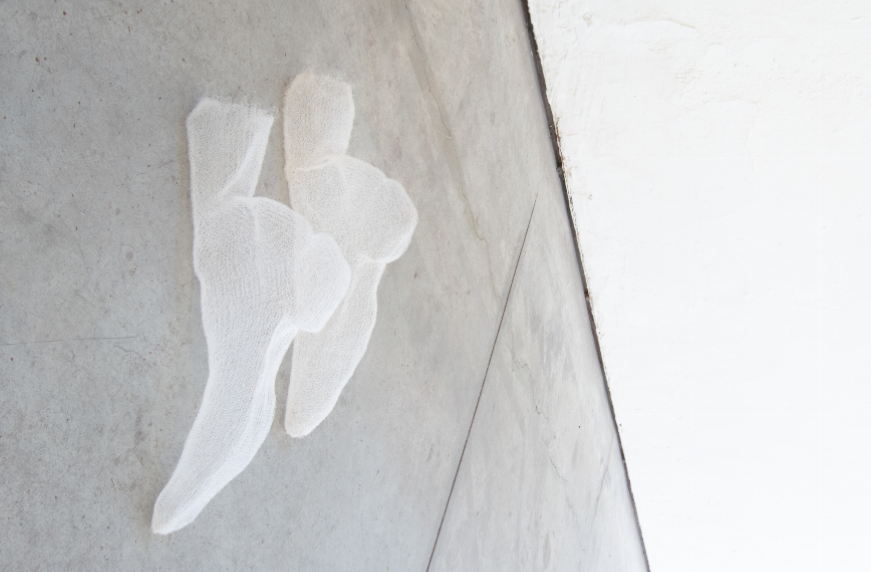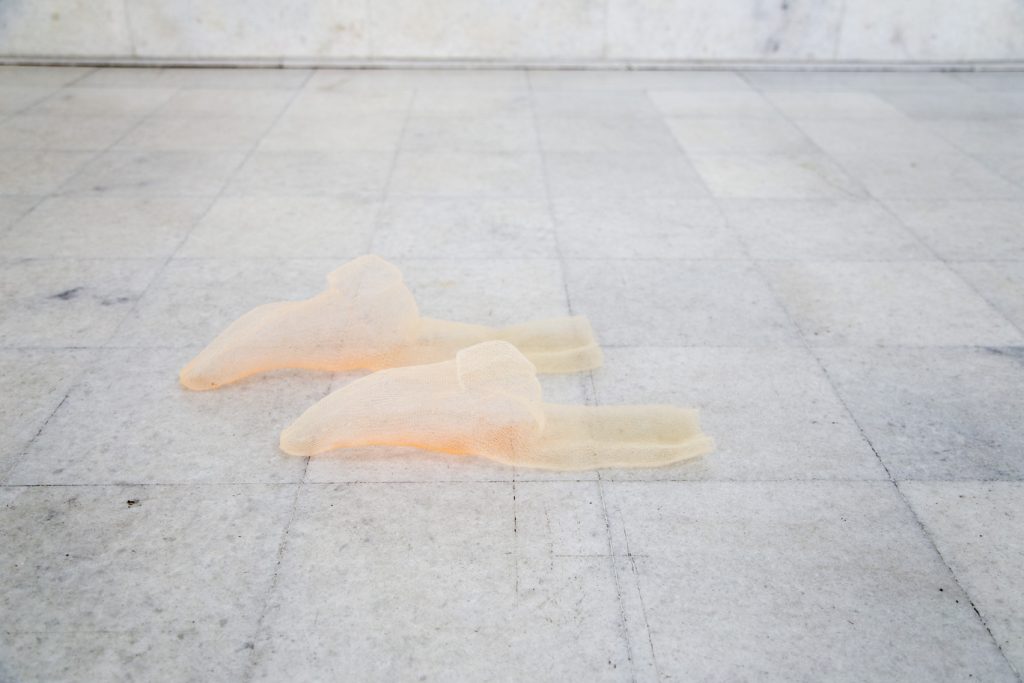Boots TR131
2021; Nylon, acrylic paint



Venue: Galerija Kresija, Ljubljana; VIR Viafarini Milano; Galerija Piranski svetilnik, Piran
Photography: Urška Pečnik, Emanuele Sosio Galante
We take our synthetic fibers and run with them.
The works by Ana Mrovlje take shape as synthetic appendages, prosthetics, and at times counterfeits that imitate the human form: be it the “dramatism” of hair fibers (their intensive shine) or the bending and folding of limbs (their curvatures). In doing so, they point to the looming absence of the thing imitated and to an event already passed, of which only synthetic traces, those resistant to the passing of time, remain. The exhibition is static and singular yet filled with countless potentialities that imbue its space with overlapping fictions.
Sw…
…oosh, came down the floor. The gallery space loudly shifted downwards like an elevator in free fall before suddenly stopping. What had been reliably solid only a minute ago suddenly liquified in its upper crust, leaving Eli standing waist-deep in what seemed to her like a cement-type substance but could as well have been mud. The exact identity of the substance engulfing her limbs was the farthest thing from her mind, as the shift left her disoriented, confused, and for the most part, annoyed by the material betrayal of her surroundings. “What has just happened… how did it… and in an art gallery, of all places…?” Just her damn luck, she thought, as her visit to the local gallery happened to be her first in months. Even though she’d lost all interest in art a while ago, she could not deal with the monotony of “not going” anymore. It began with a discreet invitation, notification, or a simple “You’re going to the so and so, right?” from a friend, colleague, or a mere overzealous acquaintance, which slowly filled her with indescribable resentment. The more she actively tried to avoid the art world, ignore it, and hopefully, someday leave it behind, the more she was met with a persistent feeling of guilt and fear of missing out. “How can you even miss out on something that you despise?” she said to herself repeatedly, all the while aware that there is no winning when it comes to an internal argument with her guilty conscience. “It’s not as if the art would suddenly become any less bad or the people any less full of themselves if I decided to go.” And yet there she was. Not at an opening, of course, that would still give the wrong impression, signalize a sort of defeat to the people she privately rejected. No, she was alone, standing immobile amidst what she could only perceive as the art world imploding; the concrete of the gallery floor that had so often been the object of forced fascination while she was subjected to yet another wine-stained-lip yammering about who managed to score this or that artist or was all the rage for about a hot minute in the 90s, that is, an object of boredom-induced hallucination as she pictured the grains in the concrete shifting, swirling into an opening around her feet that would cause her to slowly sink and drift away from the drunk-spit-talking and the monotonous noise of mundanity that she has gotten herself into against her better judgment, now finally giving way. The fulfillment of what she’d considered only innocent musings of a bored “art person” might have even been an exciting catastrophe if the reality of it wasn’t so different from what she’d imagined. To her surprise, even disdain, the now liquified floor only managed to produce the opposite effect of the one she’d expected. With her feet still on solid ground and her legs and waist merely stuck in the thick nondescript matter, while her torso and head remained surface-level, the gallery experience she’d thought would be brief and distant, casual and non-engaging, turned out to be an experience of forced exposure to the art that was still hanging on the walls. Immobile just as she was, equally perplexed by the shifting of the exhibition space, yet undisturbed in its position and function. Eli and the artworks found themselves on an “equal footing”. Despite not matching her hallucinatory expectations, such radical ontological re-leveling could still have had profound consequences. It could have even been the thing that would finally bring her some respite from her overwhelming resentment. For was it not the promise of such peace that had called for her from these barren spaces, from the crude surfaces of concrete burdened by the weight of the symbolic renderings of art? Was it not such insufferable idealism that had fueled her cynical expulsion of what she deemed to be mere superficial ponderings of the “art-adjacent”? That brief moment of forced exposure, of being one with the object she thought she’d lost all interest in, exposed her to a despairing desire far more deep-rooted than her dismissal of the art world: the desire to find herself embedded in those objects on the wall, to not be limited solely to the excruciating confines of her subjectivity, to go beyond her feeble human self. As she stood perplexed by this realization and as the realization of what had occurred replaced the annoyed disposition that had through the years solidified itself as her mental status quo, she could slowly start to hear a distant sound: the sirens marking the immediate danger of a flood. She began to form another thought, her eyes detaching their concentrated stare from the artworks, focusing for the first time on the mud surrounding her. “Oh…” she exhaled, brushing her breath over the splattered surface of the second wave that wiped the scene, burying the art alongside her.